A Comparative Analysis of Organizational Behavior Management Theories
VerifiedAdded on 2022/11/01
|12
|3297
|444
Essay
AI Summary
This paper provides a comprehensive analysis of three key organizational behavior theories: the bureaucratic model by Max Weber, scientific management by Frederick W. Taylor, and the principles approach in public administration. It begins by defining each theory, detailing their core principles and historical context. The bureaucratic model emphasizes hierarchy, rules, and specialization. Scientific management focuses on efficiency through work simplification and standardization. The principles approach, particularly in public administration, stresses efficiency, economic success, and the well-being of employees. The paper then compares these approaches, highlighting their similarities and differences in terms of their implementation and impact on organizational structures and management practices. It also examines the limitations of each theory and their relevance in contemporary organizational settings. The paper concludes by emphasizing the importance of understanding these theories for effective leadership and organizational success, particularly in the context of public administration.
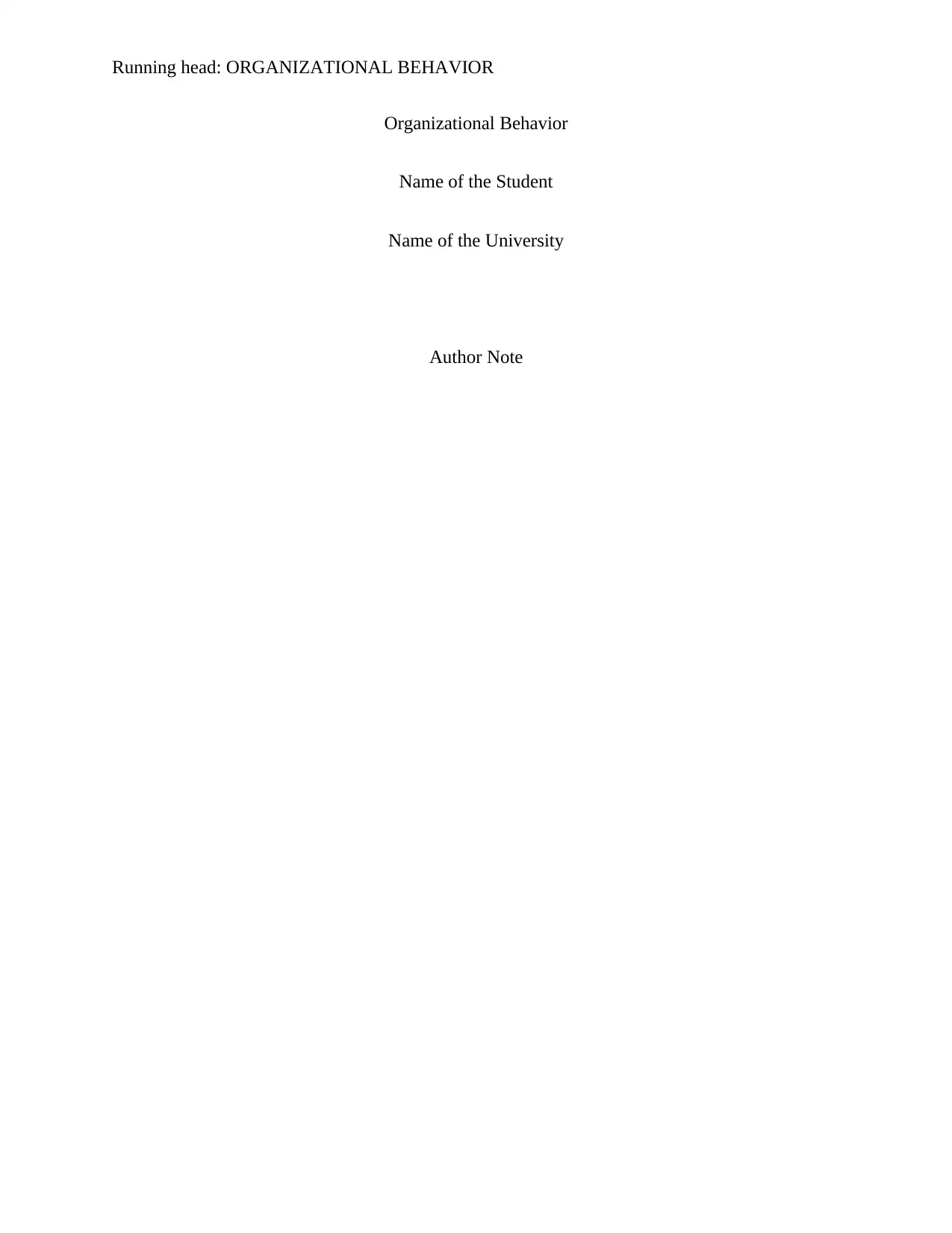
Running head: ORGANIZATIONAL BEHAVIOR
Organizational Behavior
Name of the Student
Name of the University
Author Note
Organizational Behavior
Name of the Student
Name of the University
Author Note
Paraphrase This Document
Need a fresh take? Get an instant paraphrase of this document with our AI Paraphraser
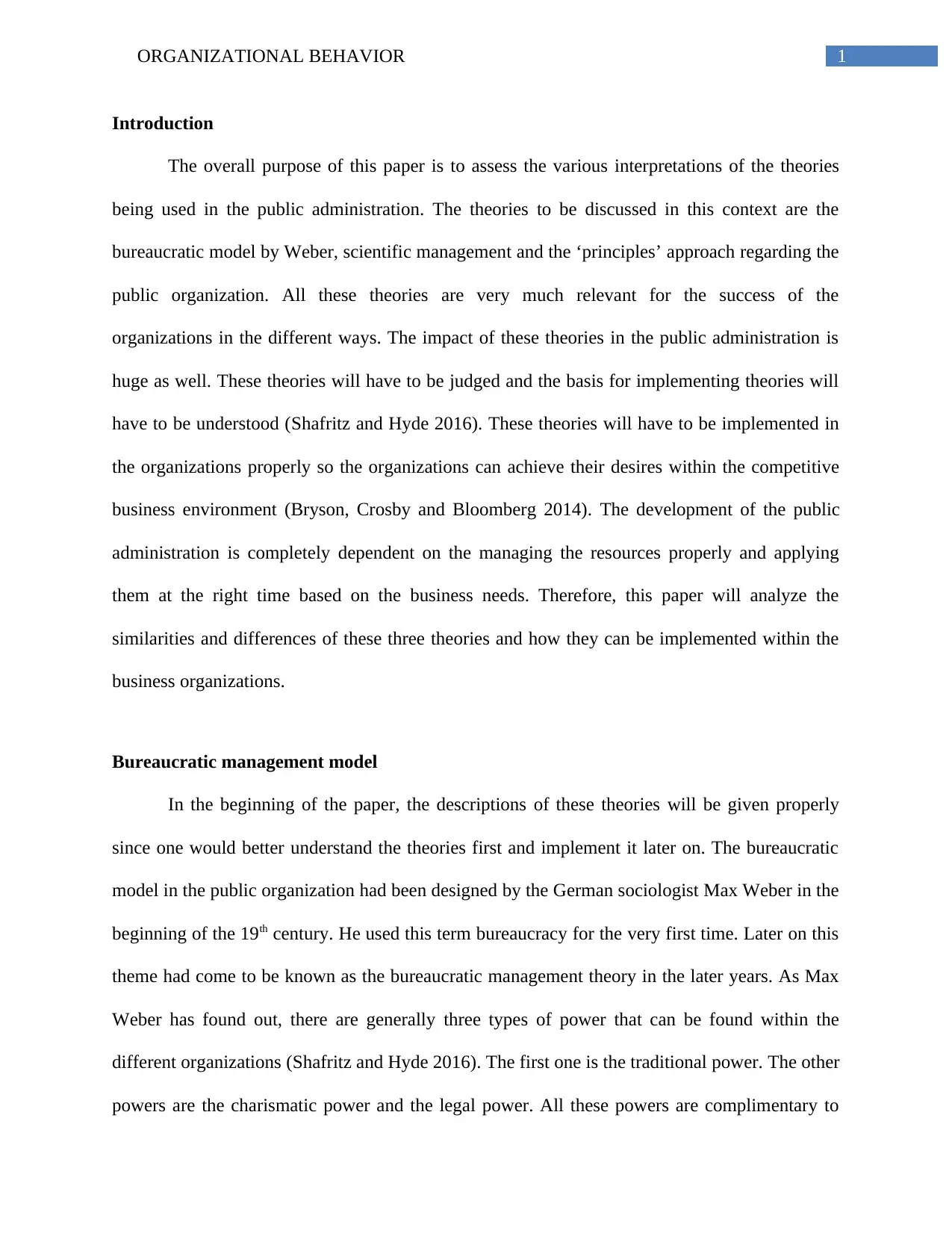
1ORGANIZATIONAL BEHAVIOR
Introduction
The overall purpose of this paper is to assess the various interpretations of the theories
being used in the public administration. The theories to be discussed in this context are the
bureaucratic model by Weber, scientific management and the ‘principles’ approach regarding the
public organization. All these theories are very much relevant for the success of the
organizations in the different ways. The impact of these theories in the public administration is
huge as well. These theories will have to be judged and the basis for implementing theories will
have to be understood (Shafritz and Hyde 2016). These theories will have to be implemented in
the organizations properly so the organizations can achieve their desires within the competitive
business environment (Bryson, Crosby and Bloomberg 2014). The development of the public
administration is completely dependent on the managing the resources properly and applying
them at the right time based on the business needs. Therefore, this paper will analyze the
similarities and differences of these three theories and how they can be implemented within the
business organizations.
Bureaucratic management model
In the beginning of the paper, the descriptions of these theories will be given properly
since one would better understand the theories first and implement it later on. The bureaucratic
model in the public organization had been designed by the German sociologist Max Weber in the
beginning of the 19th century. He used this term bureaucracy for the very first time. Later on this
theme had come to be known as the bureaucratic management theory in the later years. As Max
Weber has found out, there are generally three types of power that can be found within the
different organizations (Shafritz and Hyde 2016). The first one is the traditional power. The other
powers are the charismatic power and the legal power. All these powers are complimentary to
Introduction
The overall purpose of this paper is to assess the various interpretations of the theories
being used in the public administration. The theories to be discussed in this context are the
bureaucratic model by Weber, scientific management and the ‘principles’ approach regarding the
public organization. All these theories are very much relevant for the success of the
organizations in the different ways. The impact of these theories in the public administration is
huge as well. These theories will have to be judged and the basis for implementing theories will
have to be understood (Shafritz and Hyde 2016). These theories will have to be implemented in
the organizations properly so the organizations can achieve their desires within the competitive
business environment (Bryson, Crosby and Bloomberg 2014). The development of the public
administration is completely dependent on the managing the resources properly and applying
them at the right time based on the business needs. Therefore, this paper will analyze the
similarities and differences of these three theories and how they can be implemented within the
business organizations.
Bureaucratic management model
In the beginning of the paper, the descriptions of these theories will be given properly
since one would better understand the theories first and implement it later on. The bureaucratic
model in the public organization had been designed by the German sociologist Max Weber in the
beginning of the 19th century. He used this term bureaucracy for the very first time. Later on this
theme had come to be known as the bureaucratic management theory in the later years. As Max
Weber has found out, there are generally three types of power that can be found within the
different organizations (Shafritz and Hyde 2016). The first one is the traditional power. The other
powers are the charismatic power and the legal power. All these powers are complimentary to
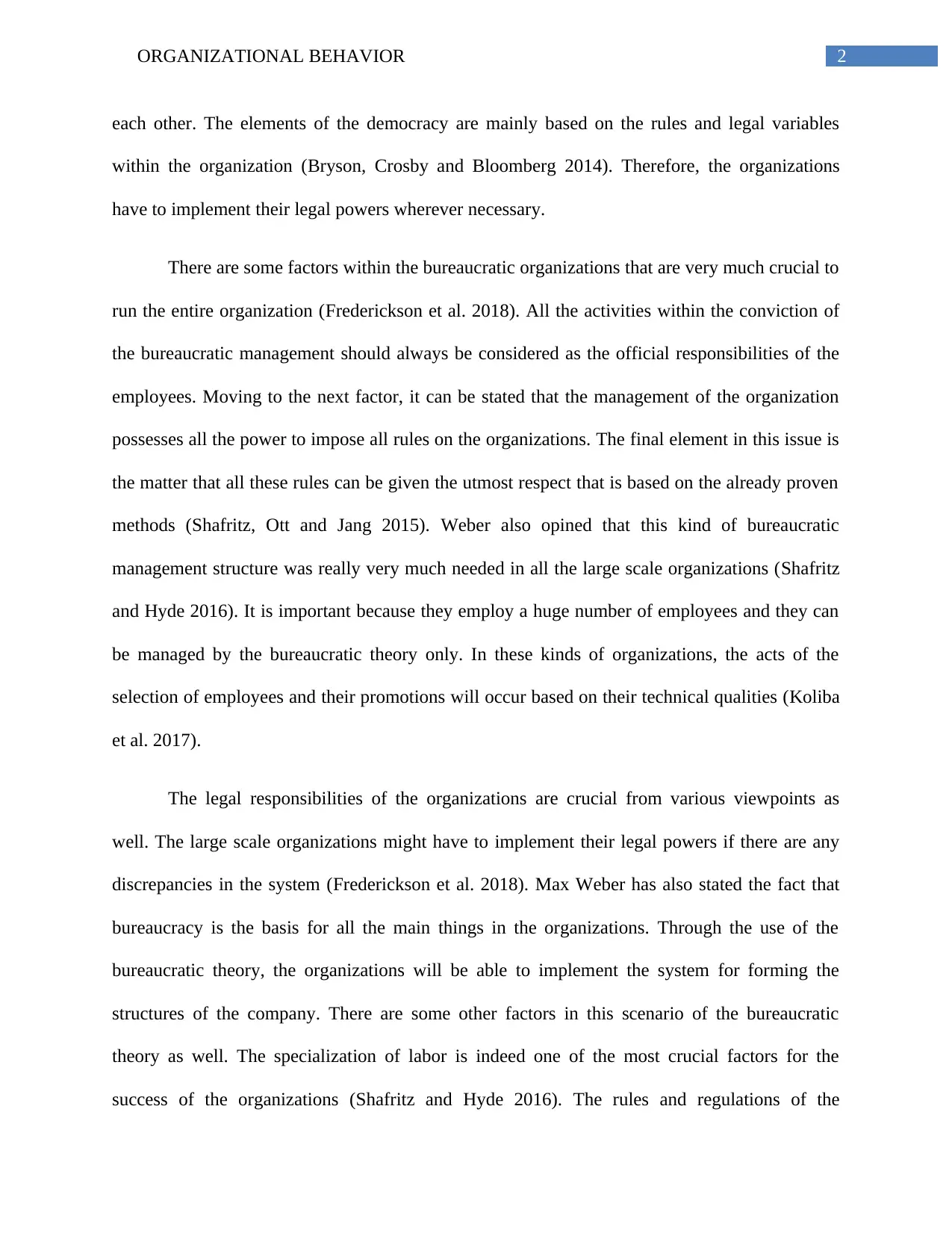
2ORGANIZATIONAL BEHAVIOR
each other. The elements of the democracy are mainly based on the rules and legal variables
within the organization (Bryson, Crosby and Bloomberg 2014). Therefore, the organizations
have to implement their legal powers wherever necessary.
There are some factors within the bureaucratic organizations that are very much crucial to
run the entire organization (Frederickson et al. 2018). All the activities within the conviction of
the bureaucratic management should always be considered as the official responsibilities of the
employees. Moving to the next factor, it can be stated that the management of the organization
possesses all the power to impose all rules on the organizations. The final element in this issue is
the matter that all these rules can be given the utmost respect that is based on the already proven
methods (Shafritz, Ott and Jang 2015). Weber also opined that this kind of bureaucratic
management structure was really very much needed in all the large scale organizations (Shafritz
and Hyde 2016). It is important because they employ a huge number of employees and they can
be managed by the bureaucratic theory only. In these kinds of organizations, the acts of the
selection of employees and their promotions will occur based on their technical qualities (Koliba
et al. 2017).
The legal responsibilities of the organizations are crucial from various viewpoints as
well. The large scale organizations might have to implement their legal powers if there are any
discrepancies in the system (Frederickson et al. 2018). Max Weber has also stated the fact that
bureaucracy is the basis for all the main things in the organizations. Through the use of the
bureaucratic theory, the organizations will be able to implement the system for forming the
structures of the company. There are some other factors in this scenario of the bureaucratic
theory as well. The specialization of labor is indeed one of the most crucial factors for the
success of the organizations (Shafritz and Hyde 2016). The rules and regulations of the
each other. The elements of the democracy are mainly based on the rules and legal variables
within the organization (Bryson, Crosby and Bloomberg 2014). Therefore, the organizations
have to implement their legal powers wherever necessary.
There are some factors within the bureaucratic organizations that are very much crucial to
run the entire organization (Frederickson et al. 2018). All the activities within the conviction of
the bureaucratic management should always be considered as the official responsibilities of the
employees. Moving to the next factor, it can be stated that the management of the organization
possesses all the power to impose all rules on the organizations. The final element in this issue is
the matter that all these rules can be given the utmost respect that is based on the already proven
methods (Shafritz, Ott and Jang 2015). Weber also opined that this kind of bureaucratic
management structure was really very much needed in all the large scale organizations (Shafritz
and Hyde 2016). It is important because they employ a huge number of employees and they can
be managed by the bureaucratic theory only. In these kinds of organizations, the acts of the
selection of employees and their promotions will occur based on their technical qualities (Koliba
et al. 2017).
The legal responsibilities of the organizations are crucial from various viewpoints as
well. The large scale organizations might have to implement their legal powers if there are any
discrepancies in the system (Frederickson et al. 2018). Max Weber has also stated the fact that
bureaucracy is the basis for all the main things in the organizations. Through the use of the
bureaucratic theory, the organizations will be able to implement the system for forming the
structures of the company. There are some other factors in this scenario of the bureaucratic
theory as well. The specialization of labor is indeed one of the most crucial factors for the
success of the organizations (Shafritz and Hyde 2016). The rules and regulations of the
⊘ This is a preview!⊘
Do you want full access?
Subscribe today to unlock all pages.

Trusted by 1+ million students worldwide

3ORGANIZATIONAL BEHAVIOR
organizations are set in the most formal ways. Critics have also pointed out that the hierarchy of
the organization is designed well for the benefits of all levels of employees.
The authority of the organizations should be able to govern it with well-preparedness.
The rules are made in such a way that the employees can follow them properly and learn new
things effectively as well (Koliba et al. 2017). The subordinate employees will have to follow the
orders and directions of their supervisors in a diligent manner. Therefore, they can also appeal to
their higher authorities if they feel to be deprived. The bureaucratic organizations or approach of
Max Weber will have to follow certain principles (Bryson, Crosby and Bloomberg 2014). These
are specialty of organizations according to their functions, up-focused and in-focused vision and
mission of the organizations, management system based on the rules, formal structure of the
hierarchy, employment regulations based on the technical qualifications and equal treatment of
all the customers and employees (Shafritz, Ott and Jang 2015).
Scientific management approach
In the next section, the discussion topic will shift to the scientific management approach.
It is one of the innovative styles that allow the work patterns and flows to be synthesized for the
benefits of the managers. The advent of the scientific management approach was done by
Frederick W. Taylor in the early 19th century. The purpose of this approach is to design it in the
way that the efficiency of the workers can increase. The work methods in the modern times have
to go through the proper scientific methods (Hanlon 2015). Thus the working approaches of the
employees will increase indeed. After the employees follow the steps directed by the managers,
they will achieve the utmost efficiency in their work patterns. This will also be helpful for the
organizations to gain the benefits as well. The proponent of this approach Frederick W. Taylor
organizations are set in the most formal ways. Critics have also pointed out that the hierarchy of
the organization is designed well for the benefits of all levels of employees.
The authority of the organizations should be able to govern it with well-preparedness.
The rules are made in such a way that the employees can follow them properly and learn new
things effectively as well (Koliba et al. 2017). The subordinate employees will have to follow the
orders and directions of their supervisors in a diligent manner. Therefore, they can also appeal to
their higher authorities if they feel to be deprived. The bureaucratic organizations or approach of
Max Weber will have to follow certain principles (Bryson, Crosby and Bloomberg 2014). These
are specialty of organizations according to their functions, up-focused and in-focused vision and
mission of the organizations, management system based on the rules, formal structure of the
hierarchy, employment regulations based on the technical qualifications and equal treatment of
all the customers and employees (Shafritz, Ott and Jang 2015).
Scientific management approach
In the next section, the discussion topic will shift to the scientific management approach.
It is one of the innovative styles that allow the work patterns and flows to be synthesized for the
benefits of the managers. The advent of the scientific management approach was done by
Frederick W. Taylor in the early 19th century. The purpose of this approach is to design it in the
way that the efficiency of the workers can increase. The work methods in the modern times have
to go through the proper scientific methods (Hanlon 2015). Thus the working approaches of the
employees will increase indeed. After the employees follow the steps directed by the managers,
they will achieve the utmost efficiency in their work patterns. This will also be helpful for the
organizations to gain the benefits as well. The proponent of this approach Frederick W. Taylor
Paraphrase This Document
Need a fresh take? Get an instant paraphrase of this document with our AI Paraphraser

4ORGANIZATIONAL BEHAVIOR
wanted that the productivity of the employees will surely improve along with their trust on the
managers.
The steps through which the workers will be able to achieve efficiency of the workers are
simplification of the work patterns, specialization their work capacities and standardize their
efforts in order to gain the optimum results. He was of the opinion that the traditional concept of
‘boss’ should exist no more. He believed that this concept often gave the employees headache
that they were being directed forcibly and they did not have any freedom to voice their opinions
in the system (Hanlon 2015). Afterwards, he also wanted to get rid of the problems of
psychological anxiety and physical stress of the workers. He simply believed that workers would
be able to give their best efforts if they are given the training on a regular basis. The influence of
this scientific approach is still felt in the modern business world. Few critics have also
appreciated this school of thought (Waring, 2016).
This management approach has been very effective in many organizations over the years.
This is why various principles have been used to assess the importance of this management
approach. In this approach, the managers have used science instead of thumb old rules of running
the management. The old thumb rules are not completely let off but the scientific approaches
have been mixed with it for the better outcomes. The employees of the organization are selected
through the scientific method (Waring, 2016) The members of all the organizations must be
selected according to some analysis.
This will be better for the organization’s enhancement as well. The entire process should
go through the processes of training, development and organizational learning. Therefore, this
process is one of the most crucial factors for the overall success of the organization. Another
wanted that the productivity of the employees will surely improve along with their trust on the
managers.
The steps through which the workers will be able to achieve efficiency of the workers are
simplification of the work patterns, specialization their work capacities and standardize their
efforts in order to gain the optimum results. He was of the opinion that the traditional concept of
‘boss’ should exist no more. He believed that this concept often gave the employees headache
that they were being directed forcibly and they did not have any freedom to voice their opinions
in the system (Hanlon 2015). Afterwards, he also wanted to get rid of the problems of
psychological anxiety and physical stress of the workers. He simply believed that workers would
be able to give their best efforts if they are given the training on a regular basis. The influence of
this scientific approach is still felt in the modern business world. Few critics have also
appreciated this school of thought (Waring, 2016).
This management approach has been very effective in many organizations over the years.
This is why various principles have been used to assess the importance of this management
approach. In this approach, the managers have used science instead of thumb old rules of running
the management. The old thumb rules are not completely let off but the scientific approaches
have been mixed with it for the better outcomes. The employees of the organization are selected
through the scientific method (Waring, 2016) The members of all the organizations must be
selected according to some analysis.
This will be better for the organization’s enhancement as well. The entire process should
go through the processes of training, development and organizational learning. Therefore, this
process is one of the most crucial factors for the overall success of the organization. Another
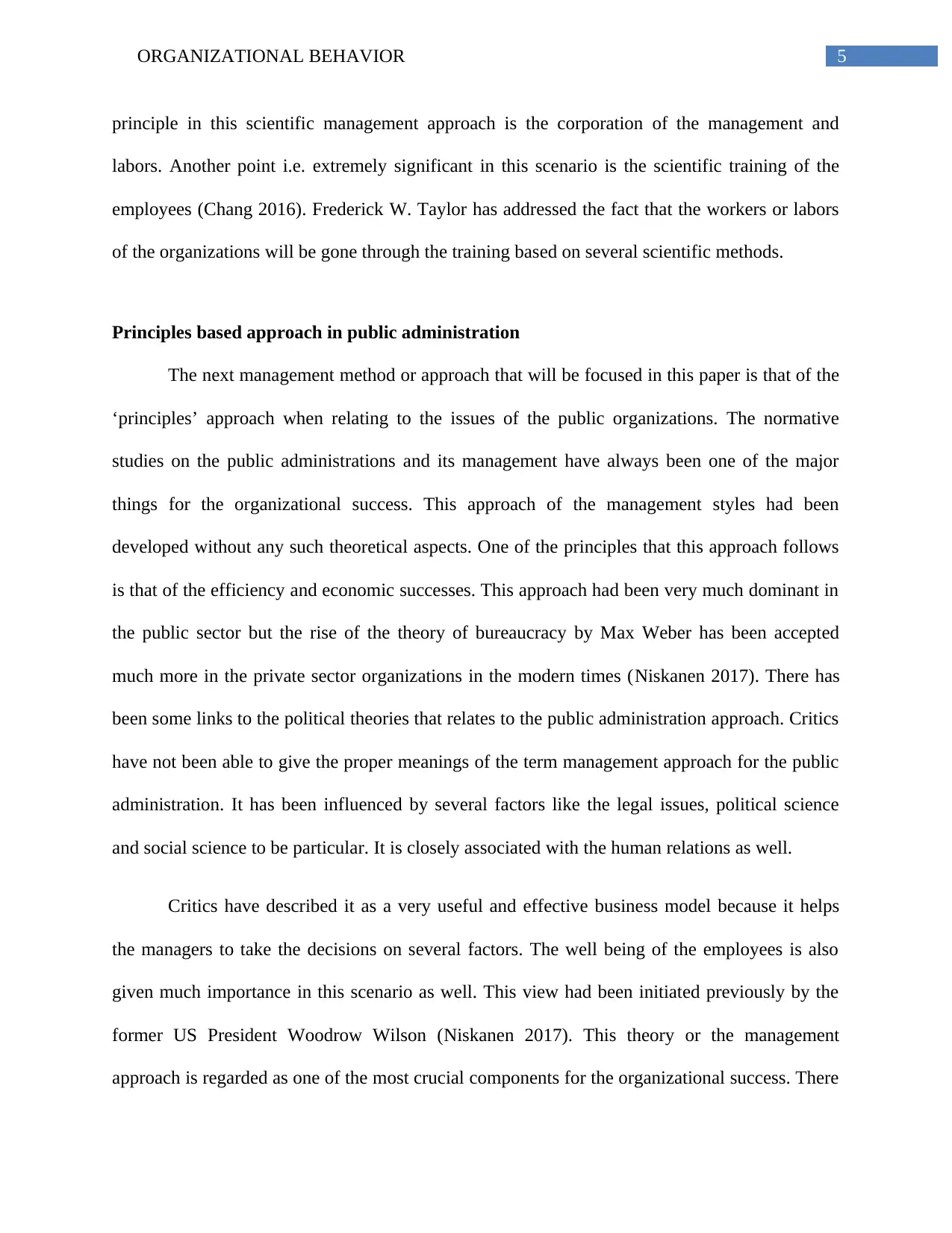
5ORGANIZATIONAL BEHAVIOR
principle in this scientific management approach is the corporation of the management and
labors. Another point i.e. extremely significant in this scenario is the scientific training of the
employees (Chang 2016). Frederick W. Taylor has addressed the fact that the workers or labors
of the organizations will be gone through the training based on several scientific methods.
Principles based approach in public administration
The next management method or approach that will be focused in this paper is that of the
‘principles’ approach when relating to the issues of the public organizations. The normative
studies on the public administrations and its management have always been one of the major
things for the organizational success. This approach of the management styles had been
developed without any such theoretical aspects. One of the principles that this approach follows
is that of the efficiency and economic successes. This approach had been very much dominant in
the public sector but the rise of the theory of bureaucracy by Max Weber has been accepted
much more in the private sector organizations in the modern times (Niskanen 2017). There has
been some links to the political theories that relates to the public administration approach. Critics
have not been able to give the proper meanings of the term management approach for the public
administration. It has been influenced by several factors like the legal issues, political science
and social science to be particular. It is closely associated with the human relations as well.
Critics have described it as a very useful and effective business model because it helps
the managers to take the decisions on several factors. The well being of the employees is also
given much importance in this scenario as well. This view had been initiated previously by the
former US President Woodrow Wilson (Niskanen 2017). This theory or the management
approach is regarded as one of the most crucial components for the organizational success. There
principle in this scientific management approach is the corporation of the management and
labors. Another point i.e. extremely significant in this scenario is the scientific training of the
employees (Chang 2016). Frederick W. Taylor has addressed the fact that the workers or labors
of the organizations will be gone through the training based on several scientific methods.
Principles based approach in public administration
The next management method or approach that will be focused in this paper is that of the
‘principles’ approach when relating to the issues of the public organizations. The normative
studies on the public administrations and its management have always been one of the major
things for the organizational success. This approach of the management styles had been
developed without any such theoretical aspects. One of the principles that this approach follows
is that of the efficiency and economic successes. This approach had been very much dominant in
the public sector but the rise of the theory of bureaucracy by Max Weber has been accepted
much more in the private sector organizations in the modern times (Niskanen 2017). There has
been some links to the political theories that relates to the public administration approach. Critics
have not been able to give the proper meanings of the term management approach for the public
administration. It has been influenced by several factors like the legal issues, political science
and social science to be particular. It is closely associated with the human relations as well.
Critics have described it as a very useful and effective business model because it helps
the managers to take the decisions on several factors. The well being of the employees is also
given much importance in this scenario as well. This view had been initiated previously by the
former US President Woodrow Wilson (Niskanen 2017). This theory or the management
approach is regarded as one of the most crucial components for the organizational success. There
⊘ This is a preview!⊘
Do you want full access?
Subscribe today to unlock all pages.

Trusted by 1+ million students worldwide

6ORGANIZATIONAL BEHAVIOR
are numerous things that are considered while implementing this approach properly. This
approach to the management can be made through three types of ideas.
These ideas and concepts are also regarded as the success factors for the organizations as
well. The concepts are the public administration approach of the classical period, public
management theory of the new times and finally the postmodern public management approach.
Through these different approaches, the leaders or managers will think upon the ways how the
public administration can be run perfectly (Nhema 2015). The important factors if this theory or
approach cannot be found from observing the issues in the empirical manner only. In order to
construct and implement this approach within the organizations, one must always think of the
values that are essential within the organizational backgrounds. The culture of the organizations
is effective for the benefits of the employees in different ways (Shafritz, Ott and Jang 2015).
Collaboration among the employees and managers is a distinctive feature for the overall success
of the organization. The philosophies of the organizations should be maintained while
implementing this approach. Apart from that, the managers must take the ethical considerations
and principles as well. The ideas that are distinct in the public administration are the
professionalization of employees, promotions based on their merits and always follow the non-
political system within the work process. Thus the public administration management approach
is quite different from the previous ones (Nhema 2015). All the management approaches spoken
of here have aimed at the organizational brilliance but the manner of operations is not the exact
same in different contexts.
are numerous things that are considered while implementing this approach properly. This
approach to the management can be made through three types of ideas.
These ideas and concepts are also regarded as the success factors for the organizations as
well. The concepts are the public administration approach of the classical period, public
management theory of the new times and finally the postmodern public management approach.
Through these different approaches, the leaders or managers will think upon the ways how the
public administration can be run perfectly (Nhema 2015). The important factors if this theory or
approach cannot be found from observing the issues in the empirical manner only. In order to
construct and implement this approach within the organizations, one must always think of the
values that are essential within the organizational backgrounds. The culture of the organizations
is effective for the benefits of the employees in different ways (Shafritz, Ott and Jang 2015).
Collaboration among the employees and managers is a distinctive feature for the overall success
of the organization. The philosophies of the organizations should be maintained while
implementing this approach. Apart from that, the managers must take the ethical considerations
and principles as well. The ideas that are distinct in the public administration are the
professionalization of employees, promotions based on their merits and always follow the non-
political system within the work process. Thus the public administration management approach
is quite different from the previous ones (Nhema 2015). All the management approaches spoken
of here have aimed at the organizational brilliance but the manner of operations is not the exact
same in different contexts.
Paraphrase This Document
Need a fresh take? Get an instant paraphrase of this document with our AI Paraphraser
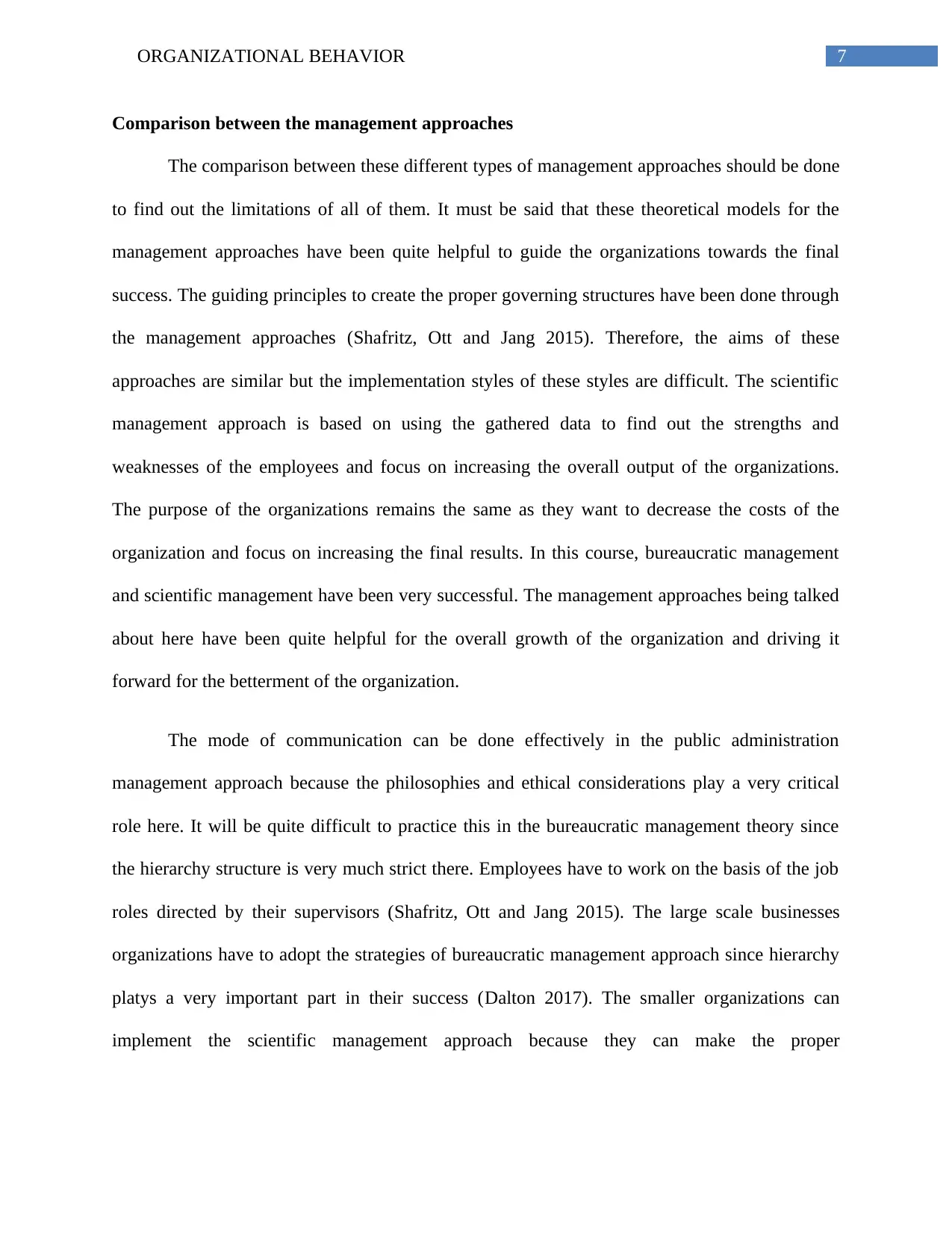
7ORGANIZATIONAL BEHAVIOR
Comparison between the management approaches
The comparison between these different types of management approaches should be done
to find out the limitations of all of them. It must be said that these theoretical models for the
management approaches have been quite helpful to guide the organizations towards the final
success. The guiding principles to create the proper governing structures have been done through
the management approaches (Shafritz, Ott and Jang 2015). Therefore, the aims of these
approaches are similar but the implementation styles of these styles are difficult. The scientific
management approach is based on using the gathered data to find out the strengths and
weaknesses of the employees and focus on increasing the overall output of the organizations.
The purpose of the organizations remains the same as they want to decrease the costs of the
organization and focus on increasing the final results. In this course, bureaucratic management
and scientific management have been very successful. The management approaches being talked
about here have been quite helpful for the overall growth of the organization and driving it
forward for the betterment of the organization.
The mode of communication can be done effectively in the public administration
management approach because the philosophies and ethical considerations play a very critical
role here. It will be quite difficult to practice this in the bureaucratic management theory since
the hierarchy structure is very much strict there. Employees have to work on the basis of the job
roles directed by their supervisors (Shafritz, Ott and Jang 2015). The large scale businesses
organizations have to adopt the strategies of bureaucratic management approach since hierarchy
platys a very important part in their success (Dalton 2017). The smaller organizations can
implement the scientific management approach because they can make the proper
Comparison between the management approaches
The comparison between these different types of management approaches should be done
to find out the limitations of all of them. It must be said that these theoretical models for the
management approaches have been quite helpful to guide the organizations towards the final
success. The guiding principles to create the proper governing structures have been done through
the management approaches (Shafritz, Ott and Jang 2015). Therefore, the aims of these
approaches are similar but the implementation styles of these styles are difficult. The scientific
management approach is based on using the gathered data to find out the strengths and
weaknesses of the employees and focus on increasing the overall output of the organizations.
The purpose of the organizations remains the same as they want to decrease the costs of the
organization and focus on increasing the final results. In this course, bureaucratic management
and scientific management have been very successful. The management approaches being talked
about here have been quite helpful for the overall growth of the organization and driving it
forward for the betterment of the organization.
The mode of communication can be done effectively in the public administration
management approach because the philosophies and ethical considerations play a very critical
role here. It will be quite difficult to practice this in the bureaucratic management theory since
the hierarchy structure is very much strict there. Employees have to work on the basis of the job
roles directed by their supervisors (Shafritz, Ott and Jang 2015). The large scale businesses
organizations have to adopt the strategies of bureaucratic management approach since hierarchy
platys a very important part in their success (Dalton 2017). The smaller organizations can
implement the scientific management approach because they can make the proper
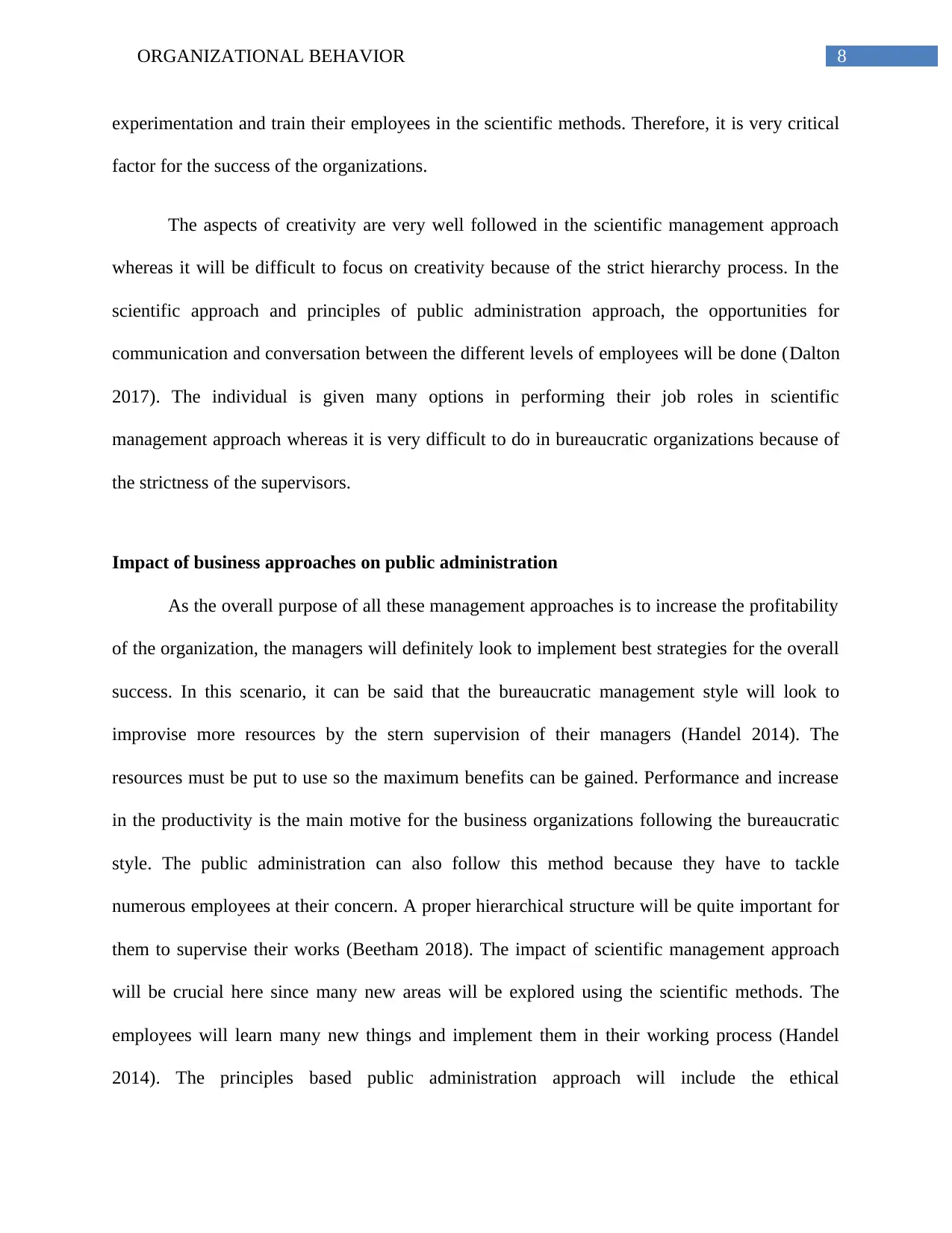
8ORGANIZATIONAL BEHAVIOR
experimentation and train their employees in the scientific methods. Therefore, it is very critical
factor for the success of the organizations.
The aspects of creativity are very well followed in the scientific management approach
whereas it will be difficult to focus on creativity because of the strict hierarchy process. In the
scientific approach and principles of public administration approach, the opportunities for
communication and conversation between the different levels of employees will be done (Dalton
2017). The individual is given many options in performing their job roles in scientific
management approach whereas it is very difficult to do in bureaucratic organizations because of
the strictness of the supervisors.
Impact of business approaches on public administration
As the overall purpose of all these management approaches is to increase the profitability
of the organization, the managers will definitely look to implement best strategies for the overall
success. In this scenario, it can be said that the bureaucratic management style will look to
improvise more resources by the stern supervision of their managers (Handel 2014). The
resources must be put to use so the maximum benefits can be gained. Performance and increase
in the productivity is the main motive for the business organizations following the bureaucratic
style. The public administration can also follow this method because they have to tackle
numerous employees at their concern. A proper hierarchical structure will be quite important for
them to supervise their works (Beetham 2018). The impact of scientific management approach
will be crucial here since many new areas will be explored using the scientific methods. The
employees will learn many new things and implement them in their working process (Handel
2014). The principles based public administration approach will include the ethical
experimentation and train their employees in the scientific methods. Therefore, it is very critical
factor for the success of the organizations.
The aspects of creativity are very well followed in the scientific management approach
whereas it will be difficult to focus on creativity because of the strict hierarchy process. In the
scientific approach and principles of public administration approach, the opportunities for
communication and conversation between the different levels of employees will be done (Dalton
2017). The individual is given many options in performing their job roles in scientific
management approach whereas it is very difficult to do in bureaucratic organizations because of
the strictness of the supervisors.
Impact of business approaches on public administration
As the overall purpose of all these management approaches is to increase the profitability
of the organization, the managers will definitely look to implement best strategies for the overall
success. In this scenario, it can be said that the bureaucratic management style will look to
improvise more resources by the stern supervision of their managers (Handel 2014). The
resources must be put to use so the maximum benefits can be gained. Performance and increase
in the productivity is the main motive for the business organizations following the bureaucratic
style. The public administration can also follow this method because they have to tackle
numerous employees at their concern. A proper hierarchical structure will be quite important for
them to supervise their works (Beetham 2018). The impact of scientific management approach
will be crucial here since many new areas will be explored using the scientific methods. The
employees will learn many new things and implement them in their working process (Handel
2014). The principles based public administration approach will include the ethical
⊘ This is a preview!⊘
Do you want full access?
Subscribe today to unlock all pages.

Trusted by 1+ million students worldwide

9ORGANIZATIONAL BEHAVIOR
considerations that will highlight the ethical practices of the organizations and earn the trust of
their customers as well.
Conclusion
In the concluding section, it can be said that the organizations must look for the best
strategies to implement in their business structure finding the best possible solutions. The use of
the scientific management approach, principles based public administration approach and
bureaucratic management approach will be highly crucial for them to implement in their business
solutions. The discussions have been done on these different management approaches. These
approaches are quite helpful based on the structure and volume of the organization. Thus, the
organizations should identify their strengths and limitations to fix what type of strategy they can
implement within their operations.
considerations that will highlight the ethical practices of the organizations and earn the trust of
their customers as well.
Conclusion
In the concluding section, it can be said that the organizations must look for the best
strategies to implement in their business structure finding the best possible solutions. The use of
the scientific management approach, principles based public administration approach and
bureaucratic management approach will be highly crucial for them to implement in their business
solutions. The discussions have been done on these different management approaches. These
approaches are quite helpful based on the structure and volume of the organization. Thus, the
organizations should identify their strengths and limitations to fix what type of strategy they can
implement within their operations.
Paraphrase This Document
Need a fresh take? Get an instant paraphrase of this document with our AI Paraphraser
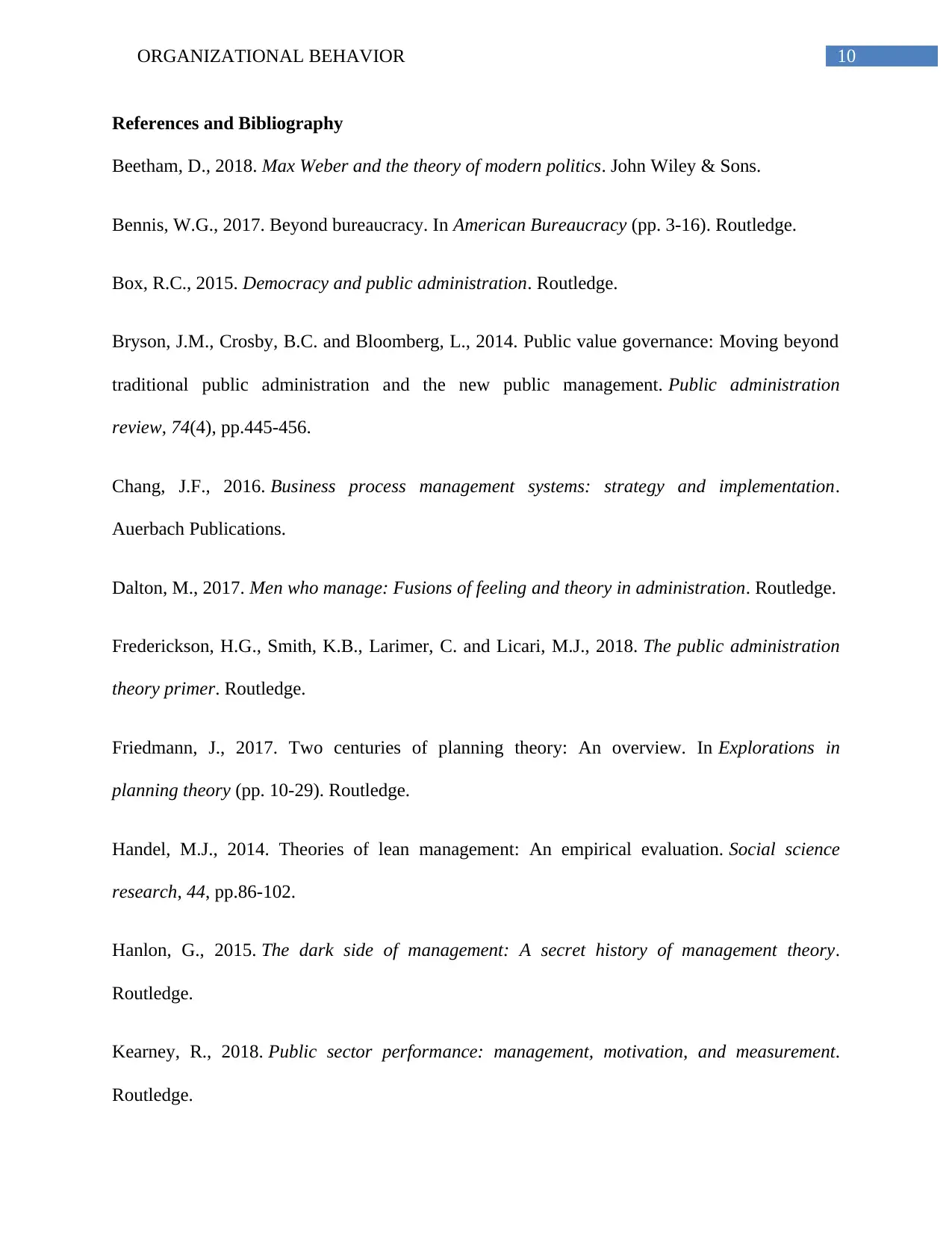
10ORGANIZATIONAL BEHAVIOR
References and Bibliography
Beetham, D., 2018. Max Weber and the theory of modern politics. John Wiley & Sons.
Bennis, W.G., 2017. Beyond bureaucracy. In American Bureaucracy (pp. 3-16). Routledge.
Box, R.C., 2015. Democracy and public administration. Routledge.
Bryson, J.M., Crosby, B.C. and Bloomberg, L., 2014. Public value governance: Moving beyond
traditional public administration and the new public management. Public administration
review, 74(4), pp.445-456.
Chang, J.F., 2016. Business process management systems: strategy and implementation.
Auerbach Publications.
Dalton, M., 2017. Men who manage: Fusions of feeling and theory in administration. Routledge.
Frederickson, H.G., Smith, K.B., Larimer, C. and Licari, M.J., 2018. The public administration
theory primer. Routledge.
Friedmann, J., 2017. Two centuries of planning theory: An overview. In Explorations in
planning theory (pp. 10-29). Routledge.
Handel, M.J., 2014. Theories of lean management: An empirical evaluation. Social science
research, 44, pp.86-102.
Hanlon, G., 2015. The dark side of management: A secret history of management theory.
Routledge.
Kearney, R., 2018. Public sector performance: management, motivation, and measurement.
Routledge.
References and Bibliography
Beetham, D., 2018. Max Weber and the theory of modern politics. John Wiley & Sons.
Bennis, W.G., 2017. Beyond bureaucracy. In American Bureaucracy (pp. 3-16). Routledge.
Box, R.C., 2015. Democracy and public administration. Routledge.
Bryson, J.M., Crosby, B.C. and Bloomberg, L., 2014. Public value governance: Moving beyond
traditional public administration and the new public management. Public administration
review, 74(4), pp.445-456.
Chang, J.F., 2016. Business process management systems: strategy and implementation.
Auerbach Publications.
Dalton, M., 2017. Men who manage: Fusions of feeling and theory in administration. Routledge.
Frederickson, H.G., Smith, K.B., Larimer, C. and Licari, M.J., 2018. The public administration
theory primer. Routledge.
Friedmann, J., 2017. Two centuries of planning theory: An overview. In Explorations in
planning theory (pp. 10-29). Routledge.
Handel, M.J., 2014. Theories of lean management: An empirical evaluation. Social science
research, 44, pp.86-102.
Hanlon, G., 2015. The dark side of management: A secret history of management theory.
Routledge.
Kearney, R., 2018. Public sector performance: management, motivation, and measurement.
Routledge.
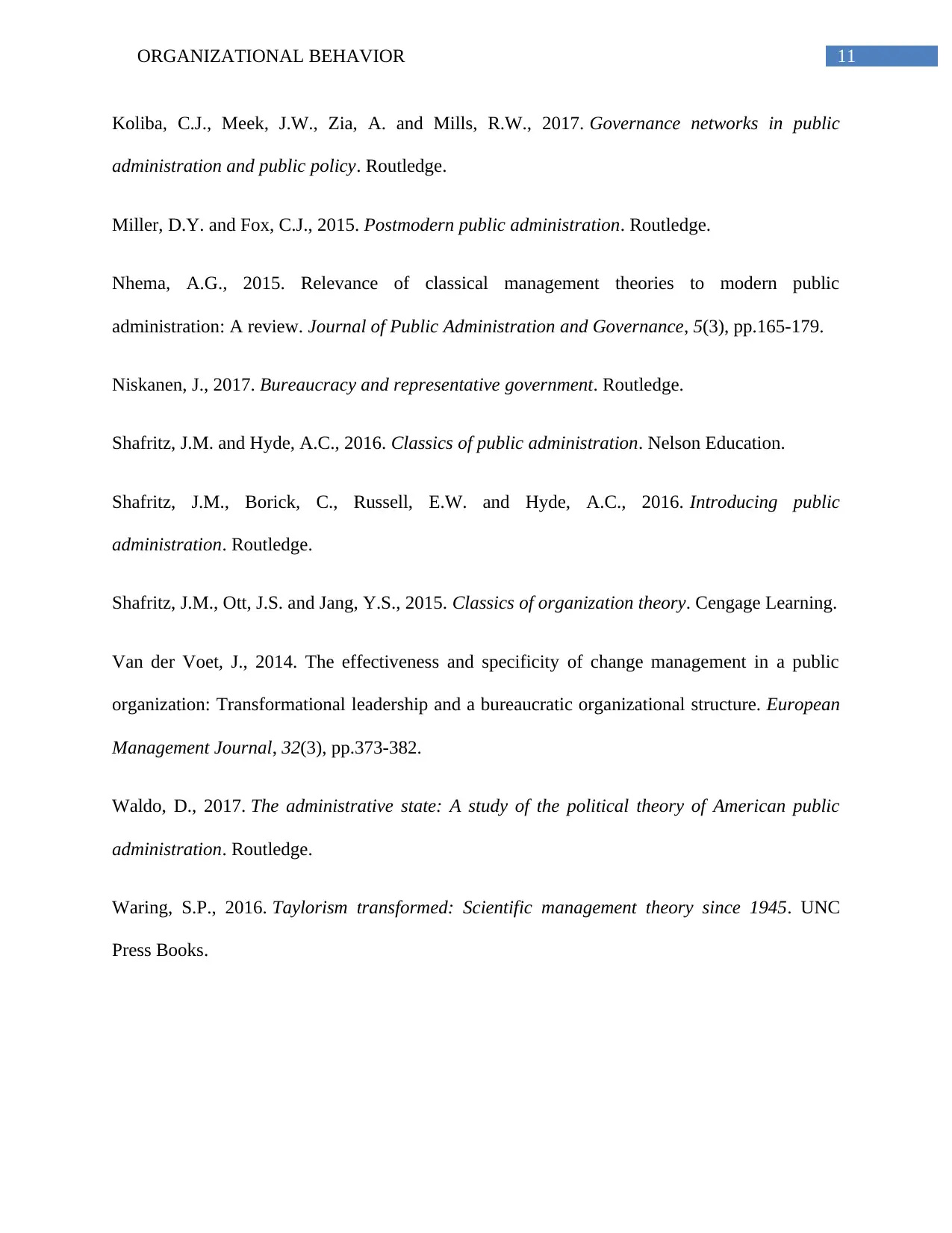
11ORGANIZATIONAL BEHAVIOR
Koliba, C.J., Meek, J.W., Zia, A. and Mills, R.W., 2017. Governance networks in public
administration and public policy. Routledge.
Miller, D.Y. and Fox, C.J., 2015. Postmodern public administration. Routledge.
Nhema, A.G., 2015. Relevance of classical management theories to modern public
administration: A review. Journal of Public Administration and Governance, 5(3), pp.165-179.
Niskanen, J., 2017. Bureaucracy and representative government. Routledge.
Shafritz, J.M. and Hyde, A.C., 2016. Classics of public administration. Nelson Education.
Shafritz, J.M., Borick, C., Russell, E.W. and Hyde, A.C., 2016. Introducing public
administration. Routledge.
Shafritz, J.M., Ott, J.S. and Jang, Y.S., 2015. Classics of organization theory. Cengage Learning.
Van der Voet, J., 2014. The effectiveness and specificity of change management in a public
organization: Transformational leadership and a bureaucratic organizational structure. European
Management Journal, 32(3), pp.373-382.
Waldo, D., 2017. The administrative state: A study of the political theory of American public
administration. Routledge.
Waring, S.P., 2016. Taylorism transformed: Scientific management theory since 1945. UNC
Press Books.
Koliba, C.J., Meek, J.W., Zia, A. and Mills, R.W., 2017. Governance networks in public
administration and public policy. Routledge.
Miller, D.Y. and Fox, C.J., 2015. Postmodern public administration. Routledge.
Nhema, A.G., 2015. Relevance of classical management theories to modern public
administration: A review. Journal of Public Administration and Governance, 5(3), pp.165-179.
Niskanen, J., 2017. Bureaucracy and representative government. Routledge.
Shafritz, J.M. and Hyde, A.C., 2016. Classics of public administration. Nelson Education.
Shafritz, J.M., Borick, C., Russell, E.W. and Hyde, A.C., 2016. Introducing public
administration. Routledge.
Shafritz, J.M., Ott, J.S. and Jang, Y.S., 2015. Classics of organization theory. Cengage Learning.
Van der Voet, J., 2014. The effectiveness and specificity of change management in a public
organization: Transformational leadership and a bureaucratic organizational structure. European
Management Journal, 32(3), pp.373-382.
Waldo, D., 2017. The administrative state: A study of the political theory of American public
administration. Routledge.
Waring, S.P., 2016. Taylorism transformed: Scientific management theory since 1945. UNC
Press Books.
⊘ This is a preview!⊘
Do you want full access?
Subscribe today to unlock all pages.

Trusted by 1+ million students worldwide
1 out of 12
Related Documents
Your All-in-One AI-Powered Toolkit for Academic Success.
+13062052269
info@desklib.com
Available 24*7 on WhatsApp / Email
![[object Object]](/_next/static/media/star-bottom.7253800d.svg)
Unlock your academic potential
Copyright © 2020–2025 A2Z Services. All Rights Reserved. Developed and managed by ZUCOL.





